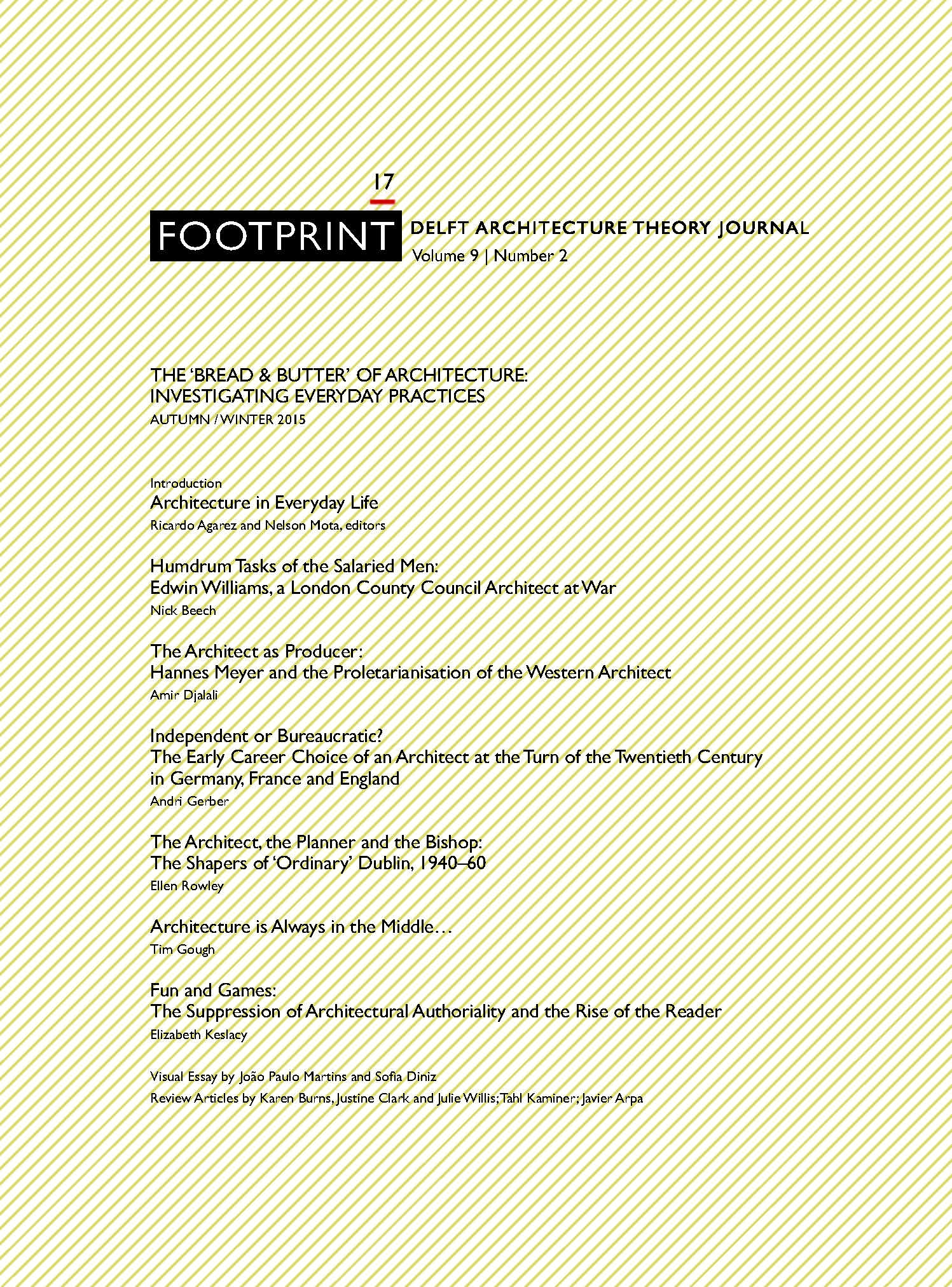Architecture is always in the middle…
DOI:
https://doi.org/10.7480/footprint.9.2.863Abstract
This essay proposes an ontology of architecture that takes its lead from the bread and butter of architecture: a flat ontology opposed to Cartesianism in the sense that no differentiation between realms (body/mind, high/low) is accepted. The work of Spinoza and Deleuze is referred to in order to flesh out such an ontology, whose aim is to destroy the very desire for architecture and architectural theory to even pose the question about the difference between bread-and-butter architecture and high architecture. Architecture is shown to be of the nature of an assemblage, of a machine or a haecceity (to use Deleuze and Guattari’s phrase), and the implications of this in relation to the question of composition and reception are outlined.
References
Bennett, Jane. Vibrant Matter: A Political Ecology of Things. Durham, NC: Duke University Press, 2009.
Deleuze, Gilles. Foucault. Translated by Seán Hand. London: The Athlone Press, 1988.
———. Logic of Sense. Translated by Mark Lester and Charles Stivale. New York: Columbia University Press, 1990.
———. Nietzsche and Philosophy. Translated by Hugh Tomlinson. London: The Althone Press, 1983.
Deleuze, Gilles and Guattari, Félix. A Thousand Plateaus: Capitalism and Schizophrenia, vol. 2. Translated by Brian Massumi. London: Continuum, 2004.
———. What is Philosophy? Translated by Graham Burchill and Hugh Tomlinson. London: Verso, 1994.
Deleuze, Gilles and Parnet, Claire. Dialogues II. Translated by Hugh Tomlinson and Barbara Habberjam. London: Continuum, 2006.
Derrida, Jacques. ‘Qual Quelle’. In Margins of Philosophy, translated by Alan Bass, 273–306. Brighton: The Harvester Press, 1982.
Dosse, François. Gilles Deleuze and Félix Guattari: Intersecting Lives. Translated by Deborah Glassman. New York: Columbia University Press, 2010.
Heidegger, Martin. Being and Time. Translated by John Macquarrie and Edward Robinson. Oxford: Basil Blackwell, 1962.
Le Corbusier. Towards a New Architecture. Translated by Frederich Etchells. New York: Dover Publications, 1986.
Leibniz , Gottfried Wilhelm. ‘Comments on Spinoza’s Philosophy’. In Philosophical Essays, translated by Roger Ariew and Daniel Garber, 272–281. Indianapolis: Hackett Publishing, 1989.
Onians, John. Bearers of Meaning: The Classical Orders in Antiquity, the Middles Ages, and the Renaissance. Cambridge: Cambridge University Press, 1988.
Pevsner, Nikolaus. An Outline of European Architecture. Harmondsworth: Penguin, 1957.
Schumacher, Patrik. The Autopoiesis of Architecture: A New Framework for Architecture. Vols. 1&2. London: Wiley, 2011, 2012.
Spinoza, Baruch. Ethics. Translated by Samuel Shirley. Indianapolis: Hackett, 1992.
Summerson, John. ‘Bread & Butter and Architecture’. Horizon 6 (October 1942): 233–243.
Venable Turner, Paul. The Education of Le Corbusier: A Study of the Development of Le Corbusier’s Thought, 1900-1920. PhD diss., Harvard University, 1971.
Whitehead, Alfred North. Science and the Modern World. New York: New American Library, 1948.
Downloads
Published
Issue
Section
License
- Authors retain copyright and grant the journal right of first publication with the work simultaneously licensed under a Creative Commons Attribution License that allows others to share the work with an acknowledgement of the work's authorship and initial publication in this journal.
- Authors are able to enter into separate, additional contractual arrangements for the non-exclusive distribution of the journal's published version of the work (e.g., post it to an institutional repository or publish it in a book), with an acknowledgement of its initial publication in this journal.



